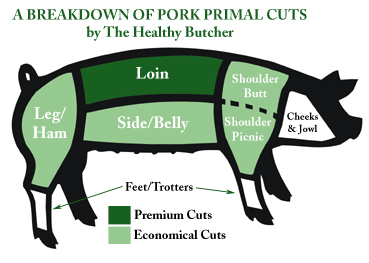
 Artisan pancetta from FraMani.com. Artisan pancetta from FraMani.com.
April 2010
Last Updated May 2018
|
 |
Different Pork Cuts & Pork Products Glossary
Page 7: Pancetta, Prosciutto & Other Pork Definitions With P To R
This is Page 7 of a nine-page glossary of different pork cuts, including terms such as pancetta, Parma ham, pork butt, pork shoulder, prosciutto and rillettes. Click on the black links below to visit other pages. See our 60+ other food glossaries.
This glossary is protected by copyright and cannot be copied in whole or in part.
Chart courtesy TheHealthyButcher.com. For a more detailed chart, see Page 1.
PATA NEGRA
Literally “black foot,” this is a casual name given to jamón ibérico, made from the native black pigs of Spain. The better grades are made from pigs that have been fed acorns, and have deep, rich flavor with an intense acorn note. Iberian pigs are fattier, producing ham that melts in the mouth. The best pigs, which are selected to become jamón ibérico di belotta, are the last free-ranging, free-grazing pigs in Europe. They are allowed to roaming the dehesas, the oak forests, of southwestern Spain, foraging for acorns in the final months prior to harvesting. See jamón ibérico.
|
PÂTÉ
A pâté is a mixture of ground meat (or vegetables) and fat. It is typically cooked into a loaf but can also be served in a crock. Pâtés can be single meat (chicken, pork, veal) or a mixture of meats. In addition to herbs, pâté can incorporate Cognac or wine, nuts and truffles. Pâté is the French word for paste, indicating elegant, well-seasoned ground meat, fish or vegetable preparations with a paste consistency.
An all-pork pâté is called pâté campagnola in Italian, pâté campagne in French. Pâtés are made in various spreadable textures and are served hot or cold as an hors d’oeuvre or a first course. They can be wrapped in fat or pastry. Technically, those wrapped in pastry (“pâté en croûte”—in crust) should be called pâté, and those in a fat-lined loaf mold (“en terrine”) should be called terrine. Pâtés are served cold, usually with toast. They can be coarse, simple preparations or fine and elegant: Both are delicious.
|
|
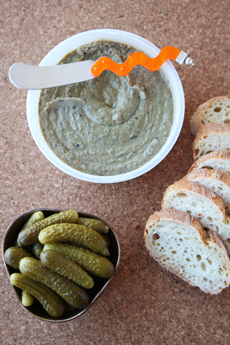
One form of pâté. Photo of Patchwork Pâté by Claire Freierman | THE NIBBLE. |
|
PANCETTA
Pancetta is unsmoked bacon: pork belly that has been salt cured, spiced and air-dried for three months—spicier but similar to prosciutto, except it comes from the belly of the pig instead of the ham, and is aged for a much shorter time. Pancetta is used in many classic dishes, such as Pasta alla Carbonara, where it is used to flavor the sauce. Each region of Italy has its own pancetta recipe, varying the spices. It can be served in very thin slices like prosciutto, in an antipasto or a first course. It also substitutes for guanciale in dishes such as Bucatini all’Amatriciana. Try this mac and cheese recipe with cavatappi and pancetta (cavatappi are small corkscrew pasta).
|
|
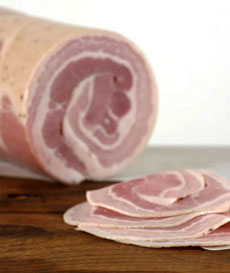
Pancetta. Available at DeLallo.com.
|
|
PARMA HAM
The English translation of prosciutto di Parma. Parma is the town in Italy that is the center for prosciutto production.
PDO
There are three European Union designations of protection for food products, that guarantee specific standards of quality based on ingredients, techniques and terrroir.
- Protected Designation of Origin (PDO) garantees that the entire product is traditionally and entirely manufactured (prepared, processed and produced) within the specific region.
|
|
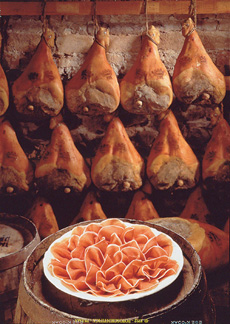
Parma ham, whole and sliced. Photo courtesy ParmaHam.com. |
- Protected Geographical Indication (PGI) status ensures that the entire product is traditionally and at least partially manufactured (prepared, processed or produced) within the specific region and thus acquire unique properties.
- Traditional Specialities Guaran-teed (TSG) differs from PDO and PGI in that there is no link to specific geographical area. Rather, certify that a particular agricultural product objectively possesses specific characteristics which differentiate it from all others in its category, and that its raw materials, composition or method of production have been consistent for a minimum of 30 years. Thus, TSG food denominations are registered trade signs with a distinctive function.
|
PEPPERONI
Pepperoni is a spicy Italian-American variety of salami made from cured pork. Narrow, smoky, and moderately hard, it is a descendant of the spicy salamis of southern Italy, made by Italian immigrants to the U.S. “Pepperoni” refers to the spicy peppers used to season the pork. In the U.S., it is perhaps the most popular pizza topping, a component of an antipasto platter and an ingredient in submarine sandwiches.
|
|
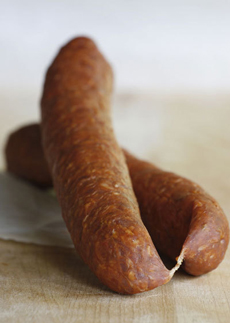
Pepperoni. Available at DeLallo.com. |
|
PICNIC HAM or PICNIC SHOULDER or PORK SHOULDER
A picnic ham is the upper portion of the foreleg (front leg) that is just below the Boston butt. A picnic “ham” is technically not a ham, since ham by definition comes from the hind legs. It does, however, go through the same curing and smoking process that hams go through, and tastes much like ham for a lower price. Slightly tougher than a legitimate ham cut, it requires longer cooking; and it has more waste because of the structure of the bone (which can be removed). This cut is especially popular in New England and the South. It is popularly cooked barbecued or roasted with a brown sugar glaze.
|
|
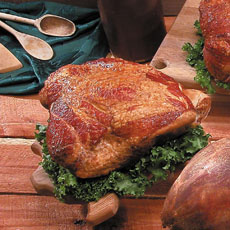
A picnic ham or pork shoulder. Available at SwissMeats.com. |
|
PIG’S FEET
See trotters.
PORCHETTA
Porchetta (por-KET-uh) is an entire deboned pig, including the head. It dates back to Roman times, where it was a popular banquet centerpiece. The pig is hand deboned, hand seasoned, sewed and roasted at more than four hours, at temperatures in excess of 500°F. This results in crackling skin and moist, seasoned meat inside. Outstanding porchetta—the entire pig plus smaller cuts—are available. Read our review of Porchetta Primata, a NIBBLE Top Pick Of The Week.
|
|
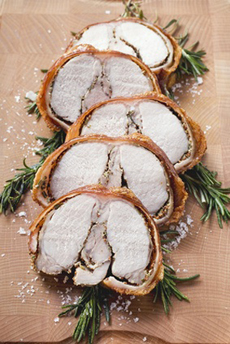
With crisp skin and moist meat, porchetta may be the best pork roast ever. Photo by Foodlovers | Fotolia. |
|
PORK BUTT or BOSTON BUTT
The shoulder, which is a primal cut, can be broken down into two sub-primal cuts: the Boston butt or pork butt and the picnic ham (see above). Boston butt is a popular cut for barbecue and braising: Because the shoulder has a large amount of connective tissue, it requires long and slow cooking. Pulled pork is made from the pork butt. With a high fat content, the pork butt is also used in sausages.
|
|
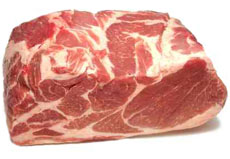
Pork butt is used for barbecue or a glazed roast. |
|
PORK RINDS or CHICHARRONES
Pork rinds (chicharrónes) are made from pork skin, with the attached fat removed. That’s the difference between pork rinds and pork cracklings. Cracklings include the fat that adheres to the skin. Because of the extra fat, cracklings are greasier, denser and a bit chewy. Pork rinds are airy like cheese puffs, and they dissolve in your mouth. Read more plus a recipe for homemade pork rinds.
|
|
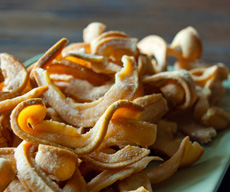
Homemade pork rinds (photo courtesy Paleo Leap).
|
|
PORK ROAST
A pork roast, the eye of the loin, is a boneless version of the rack roast of pork. The rib bones have been removed and the roast is tied to retain its shape while cooking. It’s easy to prepare, convenient to carve and ideal for feeding a sizable group at the table or on a buffet. A 3-pound roast serves five people; a 6-pound roast serves 6 to 10 people.
PORK ROLL or TAYLOR HAM
Pork roll is a product developed by John Taylor of Trenton, New Jersey, in the late 19th century. Sold under the brand name, Taylor, it was also known as Taylor ham. Sliced off a roll, it is generally grilled and frequently served as part of a breakfast sandwich with eggs and cheese. Some liken the flavor to Canadian bacon.
|
|
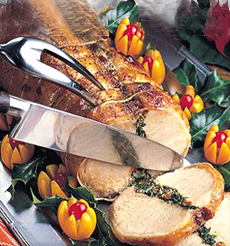
Pork roast courtesy Seaboard Foods. Get the recipe for the spinach-stuffed pork roast. |
|
PORTERHOUSE CHOP
Porterhouse chop is a fancy—and confusing—new name for the good old pork chop. In what we think is a misguided marketing program, the pork industry is borrowing some of the nomenclature of beef cuts. Why ask why? They’re hoping customers will find the fancy names beguiling and buy more. So expect to see pork cuts labeled “New York chop” after the New York steak, “porterhouse chop” after the porterhouse steak, and the sirloin chop after—you guessed—the sirloin steak. Read more here.
|
|
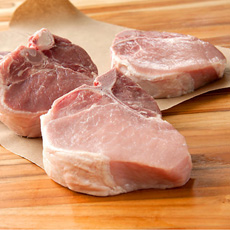
Porterhouse chop, the new name for “pork chop.” Photo courtesy D’Artagnan. |
PORTUGUESE CHORIZO
See Crusoe.
PRIMAL CUT
A primal cut of meat is one that is initially separated from the carcass during butchering, after the animal has been cut in half (see the chart at the top of the page). Almost all retail cuts come from four basic parts, known among butchers as the primal cuts: the shoulder, the loin, the belly (or side) and the leg. Different countries and regions make different cuts, or value different cuts. An example is fatback, a very important pork primal cut in Europe, which in North America is regarded mostly as trimming to be used in sausage or rendered into lard.
|
PROSCIUTTO or PROSCIUTTO CRUDO or PROSCIUTTO DI PARMA or PARMA HAM
Prosciutto is the Italian word for ham; specifically a dry-cured, uncooked ham that is aged for 400 days or longer. It originated in the hills around Parma, Italy. The pigs are fed a special diet of whey and grains, and the hams are trimmed and massaged with natural sea salt before aging. Prosciutto is served in thin slices, showing off rosy-colored meat with a pearl-white marbling of fat. Prosciutto di Parma is made from only two ingredients—pork and sea salt. What makes a great prosciutto is the artisan curing that creates prosciutto crudo (raw prosciutto, distinguished from cooked ham, or prosciutto cotto). The prosciutto (the pork leg) is carefully hand-rubbed with salt and then passes through a series of curing rooms of different temperatures and humidity levels.
|
|
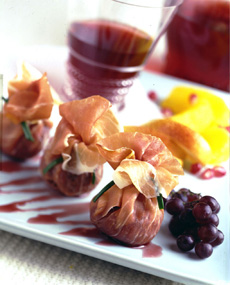
Prosciutto slices wrapped around fresh figs. Photo courtesy ParmaHam.com. |
Prosciutto made in the Parma and Langhirano areas of Italy’s Emilia-Romagna province is D.O.P.-protected (in English, D.P.O. or Domaine of Protected Origin) by the EU. Prosciutto from other cities is also D.O.P. protected, but Prosciutto di Parma is the most famous export. Prosciutto is served plain as part of an antipasto or appetizer plate, paired famously with melon and incorporated into many recipes wrapped around chicken, rolled with veal scallopini and diced into pasta and risotto, (find recipes at ParmaHam.com). In Italy, restaurants serve prosciutto in overlapping folded-over slices with bread or bread sticks as an appetizer, or wrapped around melon slices, with dates, figs and pears. Serve it with white wine, such as Italian Moscato, Pinot Grigio or a dry, sparkling wine like Prosecco. See also ham.
|
PROSCIUTTO COTTO
The Italian term for cooked ham, as opposed to prosciutto crudo, uncooked ham (see listing above).
RACK OF PORK
A rack of pork is usually 10 ribs; a half rack, five-bones, can be purchased for smaller dinners. The rack can be roasted whole or sliced into individual chops before searing or broiling.
|
|
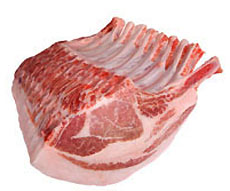
A 10-rib rack of heritage pork, available from HeritageFoodUSA.com. |
|
RED WATTLE HOG or PORK
While not old, the history of the Red Wattle hog is unclear. Their ancestors may have been native to New Caledonia, an island in the South Pacific that was colonized by the French. The first red wattles were a hybrid of French stock brought by the colonists, with the local island pigs. The hybrid emerged with ruddy hair and folds of neck skin (the wattles) that hang on each side of their jowls. They also had exquisite meat in a deep red color that interlaced with rich veins of fat. The French brought the breed to New Orleans in the 1700s, where the hearty foragers soon spread through the Southeast and oak scrub of Texas.
|
|
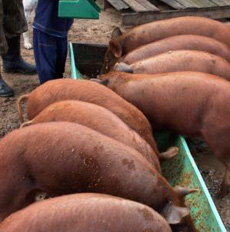
Red wattle pigs at the trough. Photo courtesy FalsterFarms.com. |
The breed was thought to be extinct; but in the late 1960s, Mr. H. C. Wengler of Texas found a few remnants in the wild and start to redevelop the breed, starting the Red Wattle movement. In the early 1980s another line of Red Wattles emerged, via a herd found in East Texas by Robert Prentice; the variety was named Timberline after the woods where they were found. It’s a bigger, leaner hog, but there are only a few breeders who own them, and the breed is on the endangered species list of the American Livestock Breeds Conservancy. Hopefully, the artisan food movement will lead to more interest. See heritage pork.
|
RIBS
There are two types of pork ribs: baby back ribs, from the loin area; and spare ribs or side ribs, which are longer and fatter, but less meaty ribs from the belly side of the pig’s rib cage. Ribs are barbecued and prepared either “wet” or “dry.” Dry ribs are rubbed with a mixture of herbs and spices. The rubs don’t require advance preparation; they can be applied just before barbecuing. “Wet” ribs are basted with sauce prior to and during the barbecuing process.
|
|
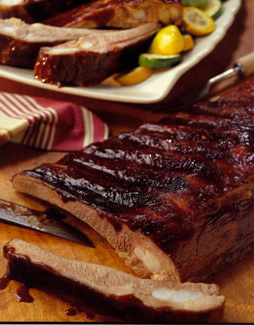
Spare ribs. Photo courtesy National Pork Board. |
|
RILLETTES
Pronounced ree-YET, rillettes are a preparation of pork that is cooked in fat, shredded, highly spiced, and meant as a spread. Rillettes were originally pork and goose, but now other meats, especially duck, fish and rabbit, are prepared in the same fashion. The meat is cubed or chopped, seasoned heavily and cooked slowly in seasoned fat until it is tender enough to be easily shredded. It is then cooled and minced or pounded into a paste with some of the cooked fat. The rillettes are stored in a ramekin, sealed with a thin layer of fat. Rillettes are typically served at room temperature, spread on bread or toast as an appetizer or with cocktails.
RIND
See cracklings.
|
|
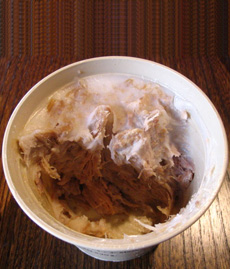
Rillettes. Photo courtesy Wikimedia. |
Continue To Next Page: Pork Definitions Sa-Sm
Go To The Article Index Above
Lifestyle Direct, Inc. All rights reserved. Photos are the copyright of their respective owners.

|





